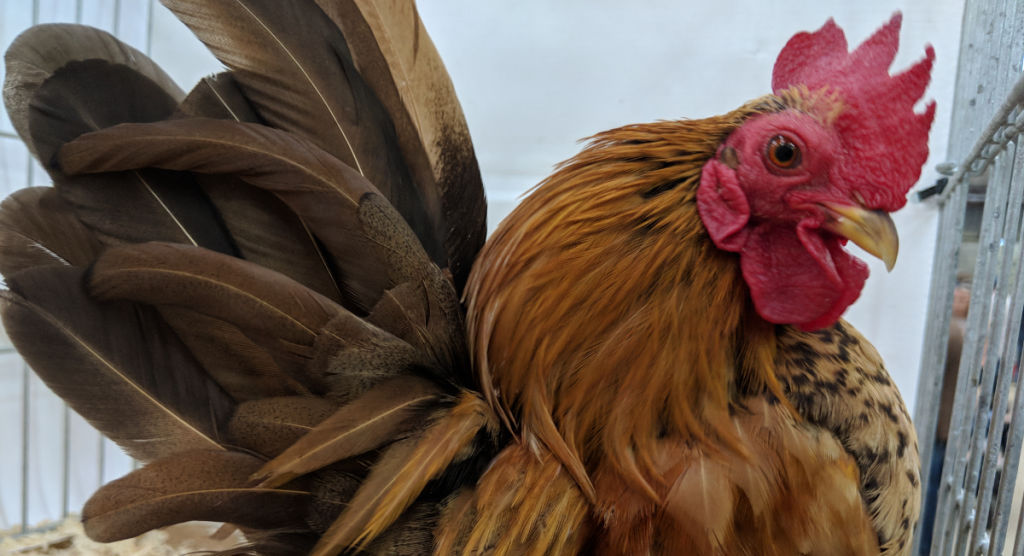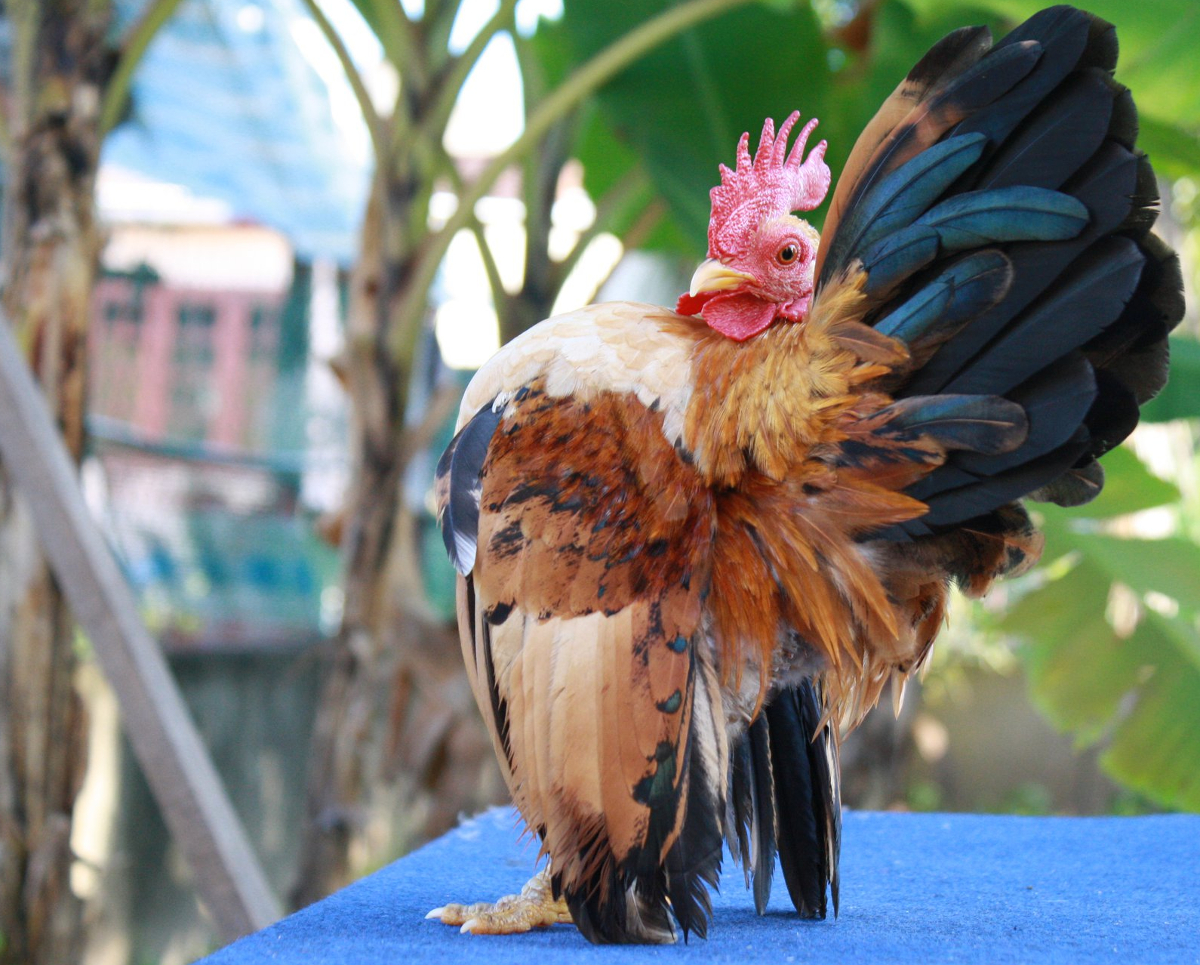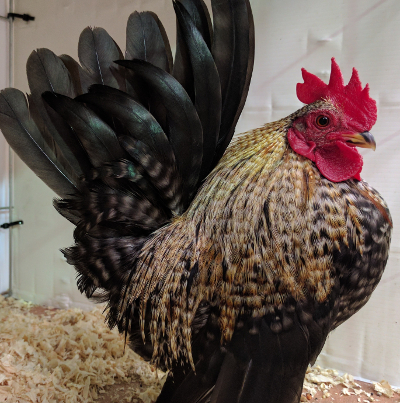Characteristics of the Serama bantam.

What makes a Serama chicken?
The Serama is characterised by their upright posture, full breast, vertical tail feathers held upright and tight up to the body and vertical wings held down nearly touching the ground. In Malaysia they are described as brave warriors and archangel chickens, because of their upright and regal appearance.
They are the smallest breed of chicken in the world. Typically under 500g, but with even smaller birds that are under 250g being bred in its native Malaysia. However, size alone does not define a Serama. A small chicken without the Serama "type" is not a Serama, but just another small bantam.
Below: A classic Serama bantam chicken.

Type – The type is the outline of the bird or "silhouette". It is the general form of the overall bird and distinguishes the Serama at a glance with it's upright tail, high prominent breast, low wing and head held far back nearly against the tail.
The overall effect of tail and neck/head is of a V shape. The back should be very short and nearly completely covered by the hackle and saddles so as to appear nearly nonexistent.
Typical Malaysian Serama Types are Slim, Ball, Apple, and Dragon.
Slim is a relatively tall, slender bird with a very small breast. This type looks as though it could fit into a cylinder without problem.
Ball are quite round in appearance. The legs are short and the wings are not held at vertical, but closer to 45 degrees or less, due to wing and leg length.
Apple The breast on the Apple Serama is a bit lower and larger and the legs on this type are medium in length.
Dragons are the “extreme” Serama. Their head is held so far back that, on some individuals, the breast is actually held higher than the head. Wings are held vertically, and legs tend to be medium to short in length.
Below: A dragon type Serama bantam.
The Serama is characterised by their upright posture, full breast, vertical tail feathers held upright and tight up to the body and vertical wings held down nearly touching the ground. In Malaysia they are described as brave warriors and archangel chickens, because of their upright and regal appearance.
However, size alone does not define a Serama. A small chicken without the Serama "type" is not a Serama, but just another small bantam.
The following describes the overall characteristics of Malaysian type. The American and European clubs have defined Similar standards of perfection and breed standards.
Carriage & Temperament - Assertive with confident bold stance yet calm and manageable. Should be easily handled and show no aggression. The bird should pose readily and when viewed from the side should create a vase like or wide ‘V’ shape outline. They shake their wings and pose, walk with pride, pull their head back to reveal a large chest, lift the legs, and in some styles have neck/head vibrations similar to that of a pigeon.
Body - The body is well muscled with breast carried high, full and well forward. From above the shape is somewhat elliptical, tapering towards the tail. The body should be short.
Wings - Fairly large wings in proportion to the body they should be held in a vertical position just clearing the ground and leaving the feet partially visible. Shoulders should be set high on the bird. Primaries are long of medium width with secondaries moderately long and broad.
Tail - Tail is full and carried high, pointing upwards and held close to the body of the bird with no space between the body and tail. The sickle feathers are relatively straight and spear like. A minimum of one inch longer than the other tail feathers, but ideally no more than a couple of inches above the head is desirable.
The remaining tail feathers should ideally be no higher than the top of the comb when the bird is standing to attention. The Main tail feathers should be broad and should over lap neatly. The tail should be open and when viewed from behind should be open to an angle of 45 degrees creating an open ‘V’ shape.
Head - Head should be small and carried well back. Head is required beyond the level of the feet and held in position of more than 90 degrees from the feet. The single comb is small to medium in size with a minimum of five serrations preferred. The comb should be straight smooth, free of folds or any deformities and tending towards flyaway type. Wattles are to compliment the comb, smaller being preferred and free from folds and wrinkles.
Legs and feet - The legs are of medium to long length, straight and set wide apart to allow for full and muscular body. They should be strong and stable. Thighs should be of medium length and well muscled with shanks of good thickness. They should not appear soft and weak.
Feathers & Colour - Like some other Asiatic breeds, they are not colour bred in their native country. Only normal feathered birds are accepted in Malaysia. Feathers held tight against the body and should not be long or flowing.
Below: A Serama male.

Silkied feathered birds are accepted in America and much of Europe. The Silkie gene was believed to be carried by some birds imported from Malaysia.
Other mutations (e.g. frizzled, rump-less and booted) have been introduced in America and some parts of Europe by crossing to other breeds.
The breast is as large as it can be given the anatomy of the bird. Apple isn't as intuitive. The breast on the Apple Serama is a bit lower and larger and the legs on this type are medium in length.
Dragons are the "extreme" Serama. Their head is held so far back that, on some individuals, the breast is actually held higher than the head. Wings are held vertically, and legs tend to be medium to short in length.
Class A Serama are very small and light weight, and as such are regarded as the lightest chickens in the world.
Serama are relatively new to the USA, having been imported in the year 2000. They were imported by two separate individuals.
Serama Bantams are currently being bred to a Standard of Perfection, based on the Standard that was developed in Malaysia. For more information, check out the Serama Standard.
The Serama breed outline:
Please note that this standard is written to assist the breeder and hence may not exactly resemble a show type standard.
Mature Cockerels
Class A - up to 350 grams (12.35 oz.)
Class B - up to 500 grams (17.64 oz.)
Class C - up to 600 grams (21.16 oz.)
Cockerels - One Class Only - 150 to 350 grams (5.29 to 12.35 oz.)
Mature Hens
Class A - up to 325 grams (11.46 oz.)
Class B - up to 425 grams (14.99 oz.)
Class C - up to 500 grams (17.64 oz.)
Pullets - One Class Only - 150 to 325 grams (5.29 to 11.46 oz.)
Chick Category - Regardless of sex - up to 150 grams (5.29 oz.)
Points:
Type - 25 points
Temperament - 20 points
Tail Carriage - 20 points
Wings - 10 points
Body - 5 points
Legs - 5 points
Feather Structure - 5 points
Comb/Wattles - 5 points
Appearance - 5 points
Total possible points - 100
Temperament: Calm, manageable. Easily handled. Showing no aggressiveness, but still possessing an assertive personality. The bird should pose easily and readily. Frightened or shy birds are as unsuitable as are aggressive and mean birds.
Tail: Very high and upright, at a 90 degree angle from the ground. The tail is carried parallel to the neck and should be relatively large and wide with full feathering. Further, the tail must have no falling to one side or the other (wry tail).
True main tail: These feathers are to be long and wide. They should overlap to some extent, the overall effect is as a set of steps, as the feathers go from the tallest front feathers to the shortest ones in back. When viewed from behind, the main tail is open at an angle of 45 degrees, creating an open V shape from behind.
Sickles: Profuse, wide and medium in length. These feathers are to be somewhat curved as is general in all rooster feathered breeds. These may protrude slightly beyond the main tail feathers and there should be as many of them as possible.
Secondary Sickle feathers: Profuse, as many as possible. These feathers should well fill in the base of the tail giving a full and profuse look to the tail base. .
Saddle: Profuse and in abundance, of medium length, flowing onto the secondaries and onto the back edge of the wing. The saddles should fill in the area between the wing and the tail.
Wings: The wings are to be large, but not so large as to drag the ground or to be longer than the foot. The wing must clear the ground and is to be well folded and should be completely vertical, straight up and down.
Shoulders: Covered at the top by the hackles and should be strong and well rounded, set high.
Couvert feathers: Should form a distinct bar below the shoulder and above the main wing feathers (primaries).
Primary and secondary feathers: Broad with the overall effect of the wing being one of great strength and fullness. The secondaries fall over the upper part of the primaries, partially covering them.
Body: The body is to be full and well muscled. From a top view the body shape is somewhat elliptical, with more prominence and width in the area of the breast. When viewed from a standing side angle, the body shape is somewhat vase like, creating a wide V shape with the head held well back and the back of the comb touching or nearly touching the tail.
Legs: The legs are to be of medium length and are to be set wide, allowing for a full and muscular undercarriage of the body. There should be no narrowness or knock knees, the overall effect being of well set, very stable legs that are a strong support to the bird. The legs must be long enough to allow the ends of the wings to be above the ground Upper Leg - Medium in length and well muscled
Shank: Medium in length of good thickness not to look too delicate. The shank must not be short or absent. The scales should be prominent and in good condition.
Spurs: The spur should be well set at the middle of the leg and be small in size. Must not interfere with the birds ability to walk or hamper proper carriage of the wing.
Toes: There must be four toes which should be well placed, solid and strong.
Feathers: All feathers must be well structured and of fine form in clean condition and showing a glossy shine. The body feathers are to be full, profuse, not fluffy, but not tightly feathered either. A medium feather structure is preferred.
The comb and wattles: The comb is to be of small to medium size and is of the single form, with five points preferred, but more points are allowed. The comb is to be of smooth structure without folds or any deformities.
The blade should lift slightly off the head giving a slight lift to the blade of the comb. The wattles are to be of complementary size to the comb, with smaller wattles being preferred. They must be free of wrinkles and folds.
Appearance: The overall appearance of the bird is to be one of health and vitality. The bird must show good temperament and be amicable to handling. The bird is to be clean, and showing proper show grooming, with all feathers intact.
There has been much confusion regarding the resemblance of Serama to Japanese bantams. The Japanese bantam was used in the breeding of the Serama but they are clearly different types of chickens.
Here is a drawing I have made to show the shape differences in Serama and Japanese bantams. Of course these are females however males are much the same allowing for natural sexual differences such as ornamental feathers and larger combs. Silkies, frizzle Serama and Japanese bantams should also follow the same outline but posses a different feather structure.
